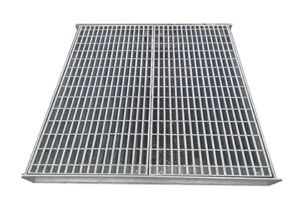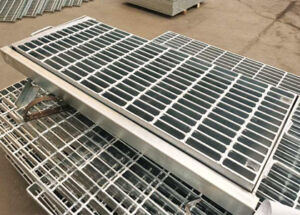Hot-dip galvanized steel grating and untreated steel grating are two common types of grating used in various industrial applications. Both types have their own advantages and disadvantages, and it’s important to understand the differences between them before making a decision on which type to use.
Hot-dip galvanized steel grating is coated with a layer of zinc that provides excellent corrosion resistance, making it ideal for outdoor or high-moisture environments. The hot-dip galvanizing process involves immersing the steel grating in a bath of molten zinc, which creates a metallurgical bond between the zinc and the steel. This results in a durable and long-lasting coating that can withstand harsh environmental conditions.
On the other hand, untreated steel grating does not have any protective coating, making it more susceptible to corrosion and rust. While untreated steel grating may be more cost-effective initially, it may require more maintenance and upkeep in the long run, especially in environments with high levels of moisture or exposure to corrosive substances.

In terms of appearance, hot-dip galvanized steel grating has a shiny, metallic finish due to the zinc coating, while untreated steel grating has a dull, matte appearance. This difference in appearance may be a consideration for projects where aesthetics are important.
When it comes to load-bearing capacity, both hot-dip galvanized and untreated steel grating are designed to support heavy loads. However, the galvanizing process may alter the dimensions of the steel grating slightly, which can affect its fit and compatibility with existing structures. It’s important to take these dimensional changes into account when choosing between the two types of grating.
Another important factor to consider is the environmental impact. Hot-dip galvanized steel grating is considered to be more environmentally friendly compared to untreated steel grating, as the zinc coating provides an additional layer of protection against corrosion, extending the service life of the grating and reducing the need for frequent replacements.
In terms of cost, hot-dip galvanized steel grating may have a higher upfront cost due to the galvanizing process, but it can result in long-term cost savings by reducing maintenance and replacement expenses. Untreated steel grating, while initially cheaper, may incur higher costs over time due to the need for frequent maintenance and potential replacement.

When it comes to installation, both types of grating require similar installation processes. However, the dimensional changes caused by the galvanizing process may require adjustments during installation to ensure proper fit and alignment. Proper installation is crucial for the performance and longevity of the steel grating, regardless of the type chosen.
In summary, the choice between hot-dip galvanized steel grating and untreated steel grating depends on various factors, including the intended application, environmental conditions, budget, and long-term maintenance considerations. While hot-dip galvanized steel grating offers superior corrosion resistance and long-term cost savings, untreated steel grating may be suitable for certain indoor applications with low corrosion risk and limited budget constraints.

